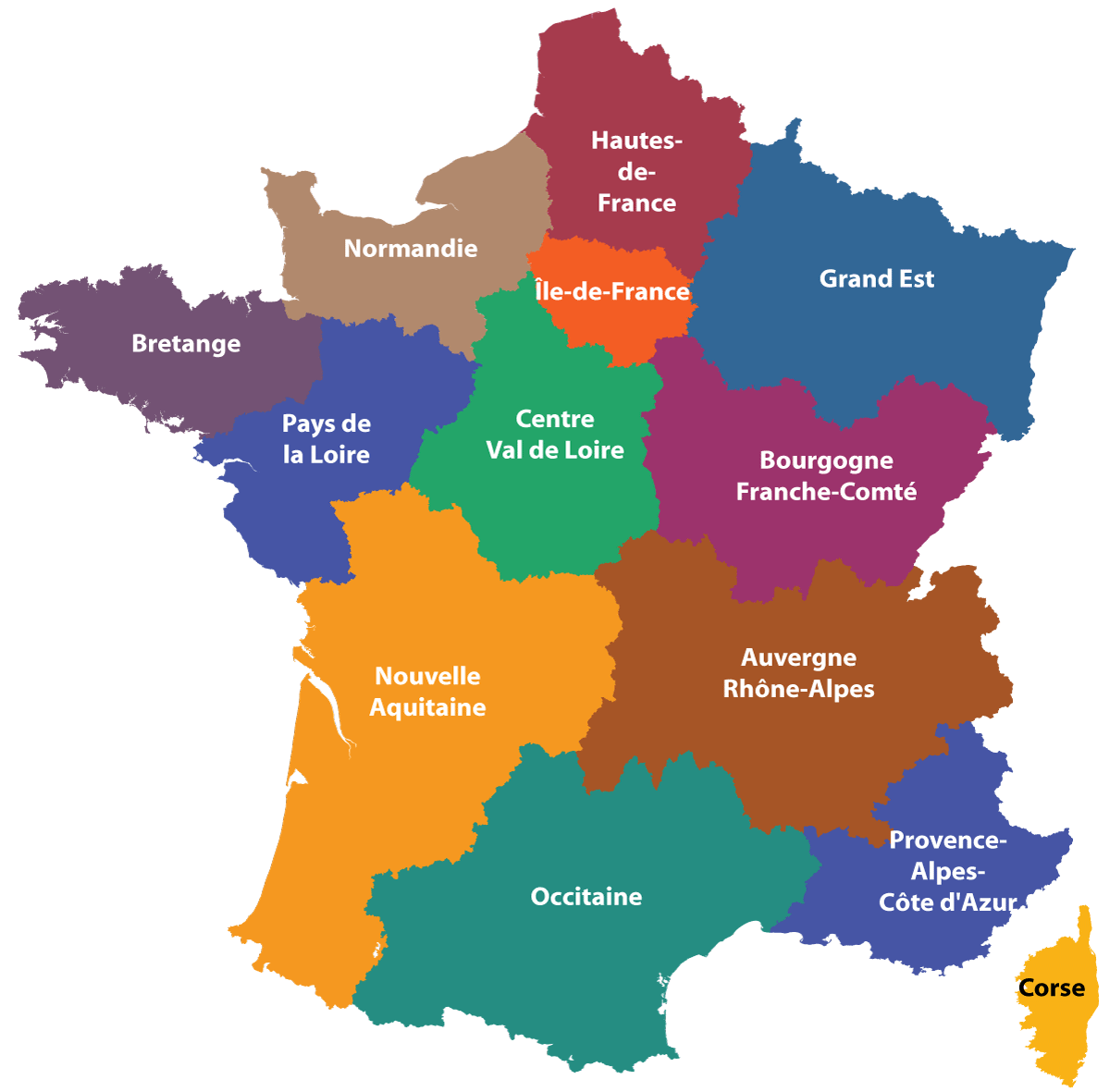13 Signature Dishes for Each Region of France
by Brian Alcamo
As centralized as the French government is, it still gives some powers to regional authorities. Metropolitan France is home to 13 administrative regions. There used to be 22, but reforms reduced that number down to 13, combining historical regions into larger, modern ones. Many people still identify with their smaller, pre-2015 regions, but we’re modern here at JP Linguistics.
French regions don’t have as much legislative power as US states, but they each have their own cultural specialties, especially when it comes to food. Read on to learn about each of metropolitan France’s 13 regions and a few of their iconic dishes.
A Map of the New 13 Regions of Metropolitan France (since 2015)
Northern France
Hauts-De-France
Hauts-De-France is France’s northernmost region, sharing a border with the sometimes-francophone Belgium. Home to Calais, a major French port city, this region features damp, rainy weather and tons of mussels. When you’re in Hauts-de-France, be sure to grab some moules frites. You won’t be disappointed.
Normandie
Normandy is known for two major exports: apples and Camembert cheese. It's a region that combines seaside culture with the best that Northern France has to offer. Try yourself some moules à la crème normande to get all that Normandy has to offer in one bite. It features local mussels cooked in white wine, garlic, cream, and specialty Norman cider (made from all of those apples).
Île-De-France
Being the political and cultural center of France, Paris and the surrounding Île-De-France region are home to cuisines from all over France and the world. But what about a food native to Île-De-France? Unlike the two other Northern French regions, Île-De-France is landlocked, so seafood is less of a historic culinary staple here. That being said, Île-De-France is known for its deserts. Centuries of entertaining kings and courts means that les sucreries have been well developed here. Try a Paris Brest on your next trip to the capital. It’s a delicate pastry filled will praline cream.
Eastern France
Grand-Est:
The Grand-Est region of France is characterized by its gradient of Germanic culture. The further east you go, the more German the region feels. It should then come as no surprise that the capital city of Strasbourg has a cuisine that competes with its architecture for the most German thing in town. When you’re tired of the Quiche Lorraine, be sure to try some baeckeoffe, a casserole made with potatoes, mutton, beef, pork, and white wine. Astuce: we’re pretty sure this is not vegan friendly.
Bourgogne-Franche Comté
Bourgogne, or Burgundy in English, is well known for its wine. Think: chardonnay and pinot noir. The region is also famous for its mustard, being home to capital city Dijon. If you’re in the area, be sure to try some bœuf bourguignon or coq au vin, depending on your meat of choice. Beef or chicken, both taste delicious when cooked in a local red wine.
Auvergne-Rhône Alpes
Auvergne-Rhone Alpes’ capital city of Lyon is often referred to as the gastronomic capital of the world, which means there’s plenty of good food to go around. If you get tired of the haute-cuisine and experimental restaurants, though, try to grab some tartiflette. This potato-based dish from Savoy features lardons, onions, and Reblochon cheese, all served up in a hot skillet.
(If you’re trying to make tartiflette at home in the US, you’ll have to substitute another cheese for Reblochon. The local delicacy is sadly unavailable in the US because it’s made with unpasteurized milk. Some recommend using delice du jura.)
Central France
Centre-Val de Loire
Centre-Val de Loire is France’s central-most region, and was a hot spot for royals and riches back in the day. This region is characterized by châteaux and nature galore, home to 3 regional parks and the massive Orléans Forest. To get a taste of this region, try some rillettes, a type of confit made from meat, most commonly from braised pork.
Western France
Bretagne
We’ve said it once and we’ll say it again: if you’re in Bretagne you better get yourself a crêpe. It’s the homeland of the crêpe. Get one. If you’re looking to change things up, get it made from buckwheat flour. Afterwards, fix it up with savory fillings and call it a galette.
Nouvelle-Aquitaine
Nouvelle-Aquitaine, a region on the Atlantic coast and home to Bordeaux, is known for its rich cuisine. Foie gras is a local delicacy, and so is anything made with duck, really. Nouvelle-Aquitaine is also where the French Basque country lies. If you want to sample a taste of Basque cuisine, try cooking some piperade or poulet basquaise. You won’t be sorry.
Pays de La Loire
The Pays de La Loire region is known for its seaside cuisine, with the long Loire river bringing fish-able territory far into the region. Nantes, the capital, is famous for its beurre blanc, a sauce that now indispensable to many fish meals in and outside of the region. It’s a sauce made from simple, easy-to-find ingredients: shallots, wine vinegar or white wine, unsalted butter, salt and black pepper. Make your own and drizzle it over the fish of your choosing for a DIY nantais meal.
Southern France
Occitanie
Occitanie, west of Provence, is the southernmost region of mainland France. Its cuisine is influenced by Spain to the south and the wide open Mediterranean sea to the East. When you’re there, be sure to try the cassoulet, a stew made of white beans, lard, pork, and other meats.
Provence-Alpes-Côte d’Azur
This region is known for its Mediterranean flare. If you weren’t hearing French all the time, you might even think you were in Italy. Lighter on the lard and heavier on the herbs, la cuisine provençale will make your mouth water. Yes, you can (and should) indulge in a ratatouille, but what about trying a pan bagnat? It’s a sandwich that can be fixed up with tuna, hard boiled eggs, and whatever vegetables you have lying around. The key here: let the sandwich sit for a bit so that the bread can soak up all the flavors from the ingredients.
Corse
Corse, or Corisca, is an island off the coast of France in the Mediterranean. Its cuisine is even more indicative of the Mediterranean lifestyle and diet than Provence. Expect to find plenty of fish, olives, and citrus. Its cuisine is often more similar to that of Italy than of France. Either way, it’s delicious. For a very-Corsican meal, try eating some pulenda, which is polenta made from chestnut flour. It’s a denser component of the Corsican palate, but will leave you perfectly satiated.
That’s It!
Thanks for reading! Which French region has your favorite cuisine? Comment below, and be sure to share this post with your friends.
(Thumbnail photo by amirali mirhashemian)





